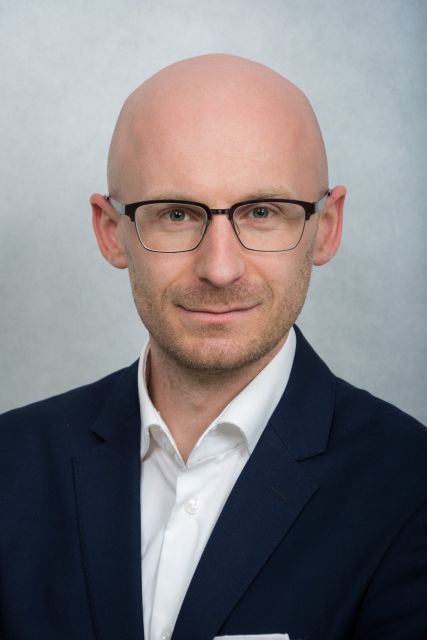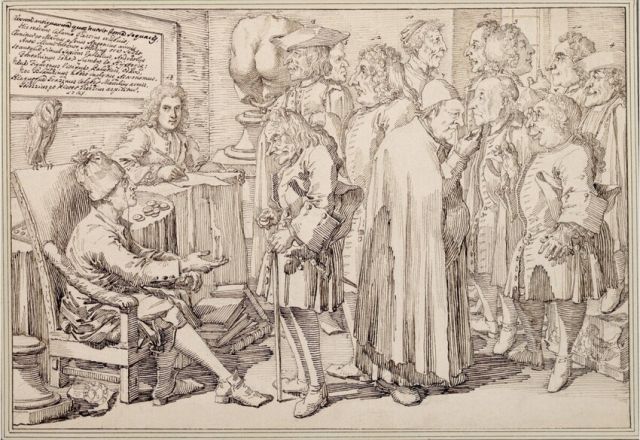Principal Investigator
:
Dr Paweł Gołyźniak
Jagiellonian University
Panel: HS3
Funding scheme
: OPUS 17
announced on
15 March 2017
Producing drawings, photographs and 3D scans are today commonly used methods for the visual documentation of archaeological artefacts, both during excavations and the publishing of museum collections. However, it took centuries to develop an effective methodology in this field. As demonstrated by research carried out within the framework of the project, a particularly significant period was the first half of the eighteenth century. The growing awareness among collectors and antiquarians of the necessity of publishing their assemblages, combined with increasing pressure from scholars to provide accurate illustrations of artefacts in publications, led to the first attempts at systematic visual documentation based on consistent principles. A pioneer in this area proved to be Philipp von Stosch (1691-1757), at the time the most prominent collector of ancient engraved gems.
The starting point for the research conducted by the international team was the verification of more than 3200 drawings of gems, discovered among others in the Princes Czartoryski Museum in Krakow and in the Kunstbibliothek in Berlin, as originating from Stosch’s former archive. These materials, together with other archival documents and the collector’s correspondence, were subjected to detailed analysis and study, resulting in a comprehensive monograph entitled Philipp von Stosch: Collecting, Drawing, Studying and Publishing Engraved Gems, published in open access by Brill Publishers (link). This publication presents and discusses Stosch’s profile and achievements in the fields of collecting, drawing, documentation, research and the publication of ancient engraved gems. At the same time, it highlights and critically examines those aspects of his activities that stand in marked contrast to the widely disseminated negative views of him as a spy and compulsive collector.
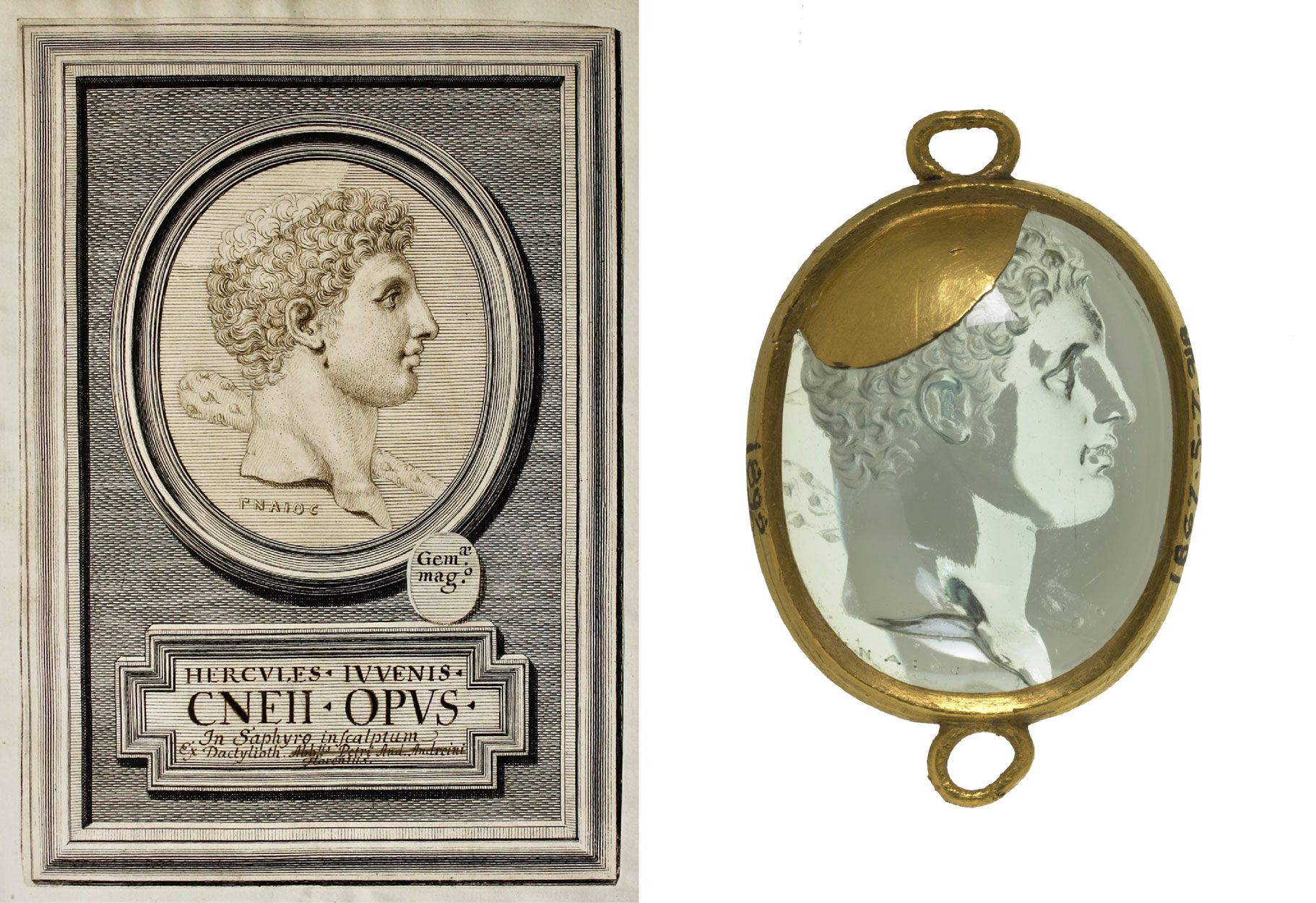 On the left: Girolamo Odam, Intaglio with the head of Heracles and a club, signed GNAIOC, The Princes Czartoryski Museum, inv. no.: MNK XV Rr. 3521, ok. 1715-1718, 268x187mm, © P. Gołyźniak. On the right: Intaglio with the head of Heracles and a club, signed GNAIOC, London, The British Museum, blue beryl (aquamarine) intaglio, 24x20mm, third quarter of the 1st century BC, ©The Trustees of the British Museum, CC BY-NC-SA 4.0.
On the left: Girolamo Odam, Intaglio with the head of Heracles and a club, signed GNAIOC, The Princes Czartoryski Museum, inv. no.: MNK XV Rr. 3521, ok. 1715-1718, 268x187mm, © P. Gołyźniak. On the right: Intaglio with the head of Heracles and a club, signed GNAIOC, London, The British Museum, blue beryl (aquamarine) intaglio, 24x20mm, third quarter of the 1st century BC, ©The Trustees of the British Museum, CC BY-NC-SA 4.0.
The research results reveal the true nature of Stosch’s achievements, portraying him as a respected antiquarian, collector, patron and scholar. It turns out that he was the first researcher of ancient glyptics to employ innovative and highly precise methods of gem drawing documentation. Many artists worked under his close supervision, including Pier Leone Ghezzi, Girolamo Odam, Bernard Picart, Antonio Maria Zanetti, Theodorus Netscher, Markus Tuscher, Johann Justin Preißler, Georg Martin Preißler, Georg Abraham Nagel and Johann Adam Schweickart. The drawings they produced served various purposes, from private studies and consultations with other collectors and scholars to illustrations for publications (such as the 1724 book on gems signed by ancient engravers), as well as for a planned supplement to that work, a catalogue of his collection and other projects that ultimately remained incomplete.
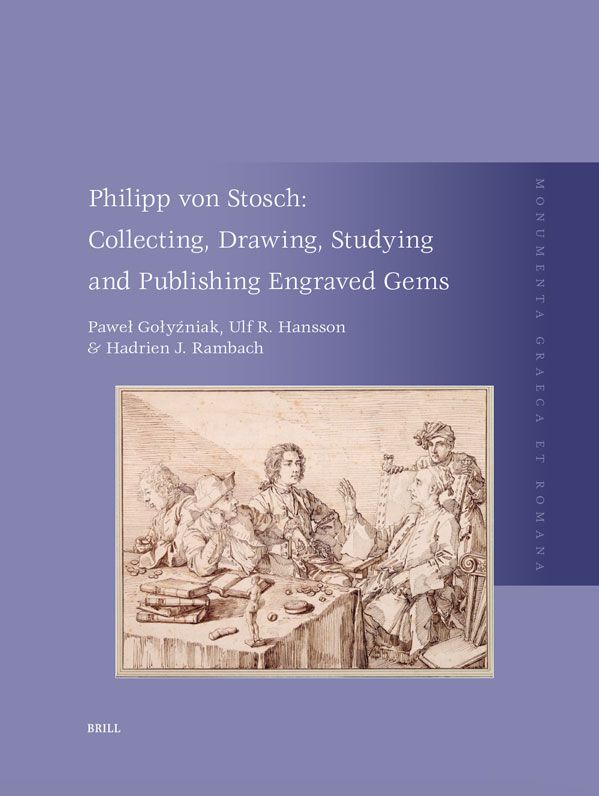 Gołyźniak, P., Hansson, U.R., Rambach, H.J. 2025. Philipp von Stosch: Collecting, Drawing, Studying and Publishing Engraved Gems. Lejda-Boston: Brill Publishers (book cover).
The rediscovered drawings and other sources confirm not only Stosch’s key role in disseminating knowledge of ancient glyptics but, above all, demonstrate his profound influence on shaping the standards of documentation and publication of archaeological artefacts. These standards contributed to the transformation of eighteenth-century antiquarianism and revolutionised the study of gems, while at the same time laying the foundations for the development of scientific archaeology and the history of ancient art. Of particular importance in this context is the recognition of Stosch’s impact on the formation of Johann Joachim Winckelmann’s views, which in turn provided the basis for writing the first synthesis of the history of ancient art (1764).
Gołyźniak, P., Hansson, U.R., Rambach, H.J. 2025. Philipp von Stosch: Collecting, Drawing, Studying and Publishing Engraved Gems. Lejda-Boston: Brill Publishers (book cover).
The rediscovered drawings and other sources confirm not only Stosch’s key role in disseminating knowledge of ancient glyptics but, above all, demonstrate his profound influence on shaping the standards of documentation and publication of archaeological artefacts. These standards contributed to the transformation of eighteenth-century antiquarianism and revolutionised the study of gems, while at the same time laying the foundations for the development of scientific archaeology and the history of ancient art. Of particular importance in this context is the recognition of Stosch’s impact on the formation of Johann Joachim Winckelmann’s views, which in turn provided the basis for writing the first synthesis of the history of ancient art (1764).
As part of the project, an evaluation was also carried out of a book devoted to gems signed by ancient engravers, published by Stosch in 1724. Modern analysis led, among other things, to the verification of nearly half of the objects described there as modern forgeries, ancient gems with signatures added at a later date, or stones whose inscriptions turned out not to be engravers’ signatures but rather the names of former owners. Moreover, in many cases, for the first time in 300 years, it was possible to rediscover the original gems and illustrate them anew.
The rediscovered fragments of Stosch’s former drawing archive of gems were subjected to detailed analysis and published in a catalogue accompanying the monograph. Approximately two-thirds of the nearly 3,200 gems depicted in the drawings were successfully identified. Around one thousand objects, however, represent a unique visual record of gems that are now lost or no longer extant. The project also explored a number of related topics. The discovered sources made it possible, among other things, to restore the memory of Girolamo Odam (1681-1740) as a collector of gems and an antiquarian, to investigate the issue of the extremely rare so-called gemmae macabre produced during the Late Roman Republic, and finally to demonstrate that certain groups of gems from Stosch’s collection were sold by his heir, Heinrich Wilhelm Muzell-Stosch, before the core of the collection was purchased in 1764 by King Frederick II of Prussia.
Both the monograph (published in open access) and the accompanying articles provide unrestricted access to the aforementioned museum collections, opening up broad prospects for further research. As part of the project, non-invasive analyses were also carried out on selected drawings from the Czartoryski Museum collection, enabling their proper conservation, storage and future display. The project was interdisciplinary in nature, combining approaches from archaeology, history, conservation and art history.
The discovery of such a large number of previously unknown drawings and their attribution to specific artists connected with Stosch’s circle in the first half of the eighteenth century has significantly enriched our knowledge of their work. Against this background, Pier Leone Ghezzi (1674-1755) stands out in particular, as it turns out that under Stosch’s strong influence he became an outstanding documenter of contemporary archaeological discoveries and antiquities found in Rome and its surroundings. His figure is the focus of another research project that I am carrying out within the framework of an NCN OPUS grant, entitled Pier Leone Ghezzi (1674-1755) and his artistic, collecting and research activities and the development of proto-archaeology in the eighteenth-century Rome.
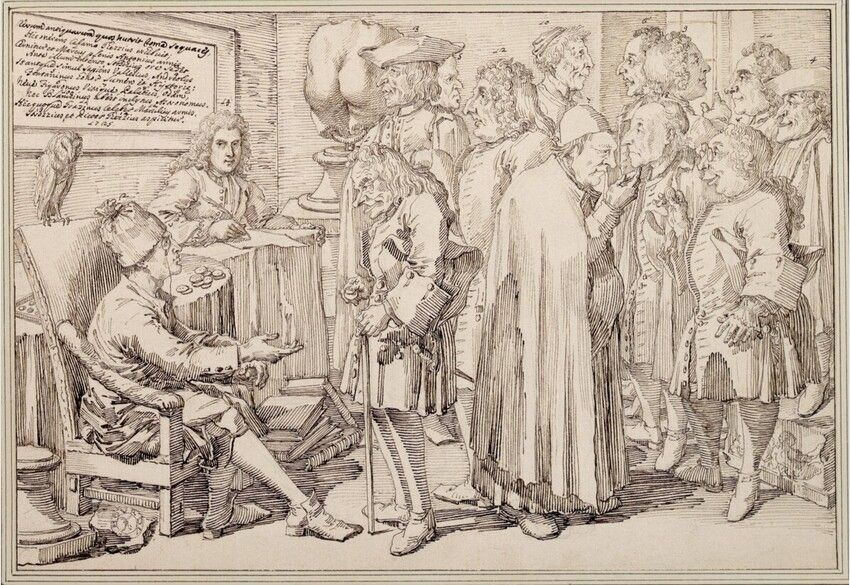 Pier Leone Ghezzi, Meeting of antiquarians at the house of Baron Philipp von Stosch (Congresso de’migliori antiquarj di Roma, 1725), Vienna, Albertina, iv. no.: 1265, 270×395 mm, ©The ALBERTINA Museum, Vienna.
Pier Leone Ghezzi, Meeting of antiquarians at the house of Baron Philipp von Stosch (Congresso de’migliori antiquarj di Roma, 1725), Vienna, Albertina, iv. no.: 1265, 270×395 mm, ©The ALBERTINA Museum, Vienna.
Project title: Philipp von Stosch (1691-1757) – collecting, visual documentation, research, and publication of ancient engraved gems - an example of transformation of eighteenth-century antiquarianism into proto-archaeology
Dr Paweł Gołyźniak
Works as a Research Fellow in the Institute of Archaeology, Jagiellonian University in Krakow. His research interests include engraved gems (ancient and neo-classical), Roman Republican and Augustan numismatics, history of antiquarianism, collecting and scholarship and the legacies of Philipp von Stosch (1691-1757) and Pier Leone Ghezzi (1674-1755). Author of Ancient Engraved Gems in the National Museum in Krakow (2017), Engraved Gems and Propaganda in the Roman Republic and under Augustus (2020), Engraved Gems from Tbilisi, Georgia. The Natsvlishvili Family Collection. Światowit Supplement Series C: Pontica et Caucasica. Volume III (2022), and with Ulf R. Hansson and Hadrien J. Rambach – – Philipp von Stosch: Collecting, Drawing, Studying and Publishing Engraved Gems (Leiden-Boston: Brill Publishers, 2025) and dozens of scientific articles.
